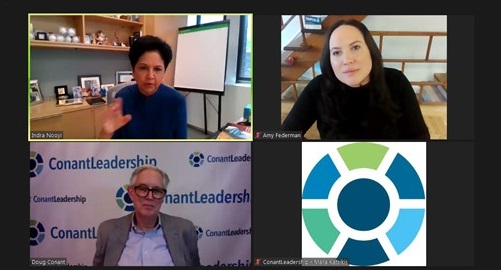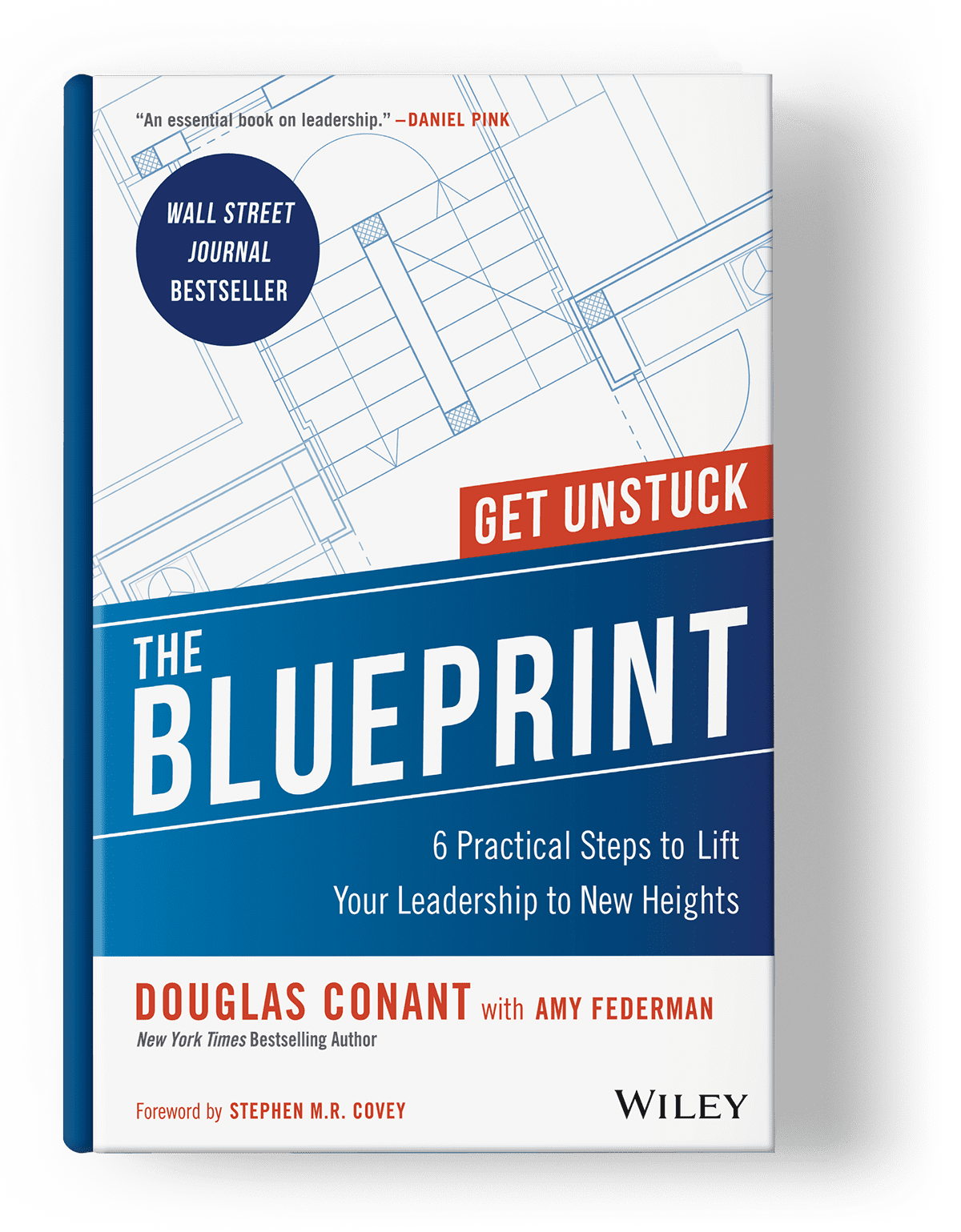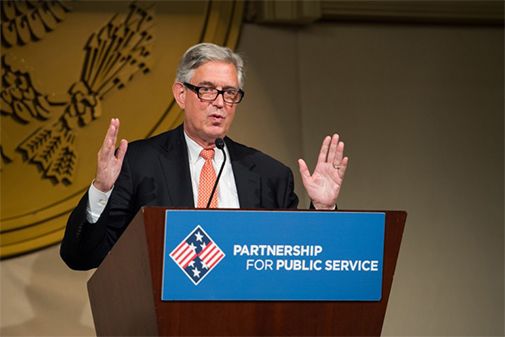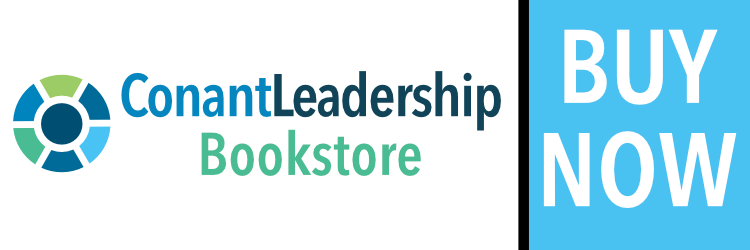‘Performance and Purpose Are Self-Reinforcing’: Indra Nooyi & Doug Conant on How to Be a Transformational Leader
This spring, ConantLeadership hosted the first ever BLUEPRINT Leadership Summit, a meeting of the top leadership minds and luminaries in the business space, inspired by the insights in the book, The Blueprint: 6 Practical Steps to Lift Your Leadership to New Heights.
At this landmark event, Indra Nooyi—Board Director at Amazon and former Chairman & CEO of PepsiCo—talked with ConantLeadership Founder, former CEO of Campbell Soup Company, and author of The Blueprint, Doug Conant, about the power of performance with purpose.
Enjoy the following smart tips for becoming a highly effective transformational leader from Indra Nooyi and Doug Conant’s conversation. (And you can watch the full video of this summit session on the power of performance with purpose here.)

Clockwise from top left: Indra Nooyi, Amy Federman, Doug Conant
Sustainability Means Thinking in Decades, Not Quarters
Both Indra Nooyi and Doug Conant agree that leading transformations that endure the test of time requires long-term thinking and determination, rather than short-sightedness. Nooyi shares, “When I first took over as CEO of PepsiCo in 2006, I was thinking about how to frame the direction of the company for the next decades,” which required first considering the company’s “role in the society in which we operate,” and charting PepsiCo’s direction accordingly.
Nooyi noted that consumers wanted healthier options, that excessive plastic waste was a cause for concern, and that to attract the “best and brightest” talent to the organization required creating a place that employees “felt proud to come work for.” With an eye towards the future, Nooyi engineered three primary pillars of sustainability in service to the company’s purpose: “Human Sustainability,” which entailed investing in “portfolio transformation” to create healthier products that could “sustain the human race” for the long haul; ”Environmental Sustainability,” which entailed reducing plastic, water use, and greenhouse gases, and prioritizing sustainable farming; and “Talent Sustainability,” which mandated fostering an environment where everybody could bring their full selves to work.
At the heart of this visionary transformation plan were the twin axles of performance and purpose. Nooyi explains: “What was interesting about the three legs of purpose was that unless you delivered performance, you couldn’t sustain purpose. Unless you delivered purpose, you couldn’t sustain performance. So, performance and purpose were self-reinforcing. And they were a virtuous circle.”
Both experts advise that long-lasting transformations—in which performance and purpose co-advance the agenda in lockstep with one another—hinge on adopting more enlightened views about the role of the corporation in the world at large. Rather than the outdated model in which a company sets performance numbers and focuses solely on hitting them, in Nooyi’s words, “quarter after quarter, irrespective of how you get those numbers and the cost to society,” leaders must adapt a “holistic perspective,” which acknowledges that “the success of the company and the success of the societies in which it operates are linked.” She emphasizes that leaders should ask themselves this question: “How am I running this company to benefit society over the long-term?”
Conant stresses that this holistic approach is not optional; it’s a must-do. He reminds leaders that their organization “needs to reflect the expectations of society,” or else, “your company is at risk.” Nooyi backs up this warning, cautioning that if leaders do not undertake transformations “with a view to the future,” and with a view to “changes in the world,” your company “will have a short lifespan.” Today’s leaders who wish to create sustainable transformations that serve all their stakeholders must think in decades, not quarters.
When the Going Gets Tough, Keep Going
Transformational leadership does not exist in a vacuum; it contends with a variety of stakeholders, many of whom may still hold entrenched old-fashioned views—steeped in short-termism—about the way things should be done. So, when you do build a modern, sustainable vision with a long-term view that honors society, you will inevitably encounter detractors.
Nooyi shares her experience early in her plan for reimagining PepsiCo: “We had to make some tough changes to our portfolio,” in order to execute the bold future-forward direction—and during the transitional period, “a couple years, we underperformed.” The naysayers were loud: “We got killed for it,” she recalls. But the criticism didn’t stop her from charging forward: “You don’t back off when you’re on a major transformation,” just because you’re taking fire. Enlisting deep support from her board was critical to maintaining momentum and realizing the company’s full potential: “Our board was fantastic. They were steadfast that this was the direction,” and when complaints piled up, the board stood firm, assuring cynics “we know what we’re doing” and “we’re gonna keep going.” It paid off. Over time, PepsiCo did very well, outperforming the S&P 500, their peer group index—and they accomplished it in a way that was aligned with a higher purpose and laser-focused on a sustainable future.
Conant’s experience as CEO of Campbell Soup Company was similar to Nooyi’s: Over a decade, he transformed the once-beleaguered company, and lifted employee engagement scores from abysmal to top-of-class. At times, the transformation was challenging, but he persevered. Conant’s advice for staying the course in a tough environment is threefold:
1. “You’ve got to be well-grounded in your convictions. You’ve got to do your own homework,” so you have an iron-clad, evidence-based argument for proceeding with your transformation plan.
2. Then, you’ve got to be “courageous,” and to “champion” your convictions resolutely. Don’t back down when the going gets tough.
3. And finally, make sure to operate with a continuous improvement mindset: “You have to be humble enough to keep learning so that you don’t cling to a strategy that works today but might be a misstep tomorrow.”
Ultimately, transformational leadership requires patience; it’s not a quick fix. Nooyi says “don’t back off,” even when you hit roadblocks, “good strategic transformations take a few years to execute.” “You’ll always have pushback,” but the results will be worth the wait.
Lead with Curiosity and Communicate Clearly
Conant and Nooyi are unanimous that a learner’s disposition is needed in order to take audacious action that positions your enterprise for everlasting success. When it comes to being a transformational leader, Nooyi warns: “If you don’t have insatiable curiosity, it doesn’t work.” And she advocates wielding your “child-like curiosity” with a positive problem-solving frame rather than a critical frame; if you’re evaluating the impact of a crisis, like COVID for example, work to “understand the opportunities” that exist within the chaos to “intervene and make the world a better place,” rather than merely lamenting all the obstacles.
Nooyi observes that great leaders are able to metamorphosize their organizations because they craft plans that are born out of inquisitiveness, a relentless “search for information to get us to the right answers,” even in the face of unforeseen hurdles. Instead of choosing the easy solution, agile leaders will study the problems of the day and dig until they discover an innovative response that can serve their employees, their shareholders, and their communities.
Conant celebrates that this way of leading with “curiosity” extends outward from the leader and influences all their constituents—generating a learning culture that benefits the collective. He explains: “It’s not just about you as an individual,” it’s also about creating a community of people who are “bright, talented, curious, and hungry to do better. And that community is more powerful than any one individual,” or any one leader.
Once you’ve leveraged your curiosity to gather all the facts and chart a course forward that’s aligned with your higher purpose, it’s essential that you are able to communicate your plan with exquisite clarity in order to earn pervasive buy-in. Nooyi shares: “I read a lot of books about purpose. They talk about it theoretically,” often making it seem so abstract that it can sound like “management mumbo-jumbo.” To make meaningful headway, “make sure you communicate in a way that your whole organization understands,” and “talk about it in a very personal way . . . you’ve got to engage people’s hearts.” Using the example of her quest to reduce water usage at PepsiCo, Nooyi shares how she made it personal with stakeholders by drawing on her own experience growing up in a “water-distressed area” for the first 20 years of her life. It’s important to find points of resonance like this that ring true, otherwise people will “know you’re a fake.”
Building on this, Conant advocates for a practice he describes in The Blueprint and talks about often in his leadership development courses—the practice of “Declaring Yourself.” First, it’s important to “do the inside work to figure out what’s important to you,” but then, if you really want to “live purpose,” you “have to tell people” your plan for bringing that purpose to life using “words that speak to you,” and then you must “do what you say you’re going to do.” Essentially, if you want to achieve breakthrough with performance and purpose: “you’ve got to be reflective. You’ve got to declare yourself. And then you have to execute.”
Nooyi and Conant’s guidance is clear: Never stop learning and craft your communications carefully and you’ll be in a good position to catalyze abiding change.
About the Author: Amy Federman is ConantLeadership’s Director of Content and Editor in Chief and co-author with Doug Conant of the WSJ bestseller, The Blueprint.
Enjoyed these insights?
For more advice about performance, purpose, and transformational leadership, explore the full video recording of this summit session here, engage with our suite of written leadership resources here, or start your Blueprint journey by getting your signed copy of the book here.
Ready to step into your full leadership potential? Apply to our signature leadership development program, The BLUEPRINT Boot Camp by ConantLeadership, a 2-day leadership intensive offering elite level, highly interactive training with Doug Conant and a community of your peers. Learn more about this premium tier of transformational leadership development here or set up a complimentary consultation call here.
(Cover photo by Nick Fewings on Unsplash)

“Doug Conant is remarkable—and so is this work.“
– Stephen M. R. Covey
Author of The Speed of Trust

The Blueprint
6 Practical Steps to Lift Your Leadership to New Heights
By Douglas Conant with Amy Federman

Have Doug Speak at Your Event
Doug works collaboratively with event organizers to customize his material for each audience.




0 Comments